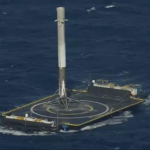“Today our adversaries perceive that space is a weak-link in our deterrence calculus” . . . “Our strategy is to strengthen that link, to assure it never breaks, and to disabuse our adversaries of the idea that our space capabilities make tempting targets.” ~ Deputy Assistant Secretary of Defense for Space Policy Doug Loverro — Testimony to the House Armed Service Strategic forces Subcommittee, March 15, 2016
At the same hearing, General John Hyten, Commander of USAF Space Command, testified that threats to U.S. space systems have reached a new tipping point, and after years of post-Cold War stagnation foreign states are focused on curbing U.S. space systems, saying that “adversaries understand our reliance on space, and they understand the competitive advantage we derive from space. The need for vigilance has never been greater.”
There are good reasons to believe U.S. initiatives can keep pace with the needed achievements if only we chose to do so. For example, the potential for needed U.S. innovation in space operations was demonstrated last week by the SpaceX launch of its Falcon rocket and to return its first stage to land on an off-shore platform to be reused in future launches. The figure below, from the Washington Post’s report on last week’s benchmark success, illustrates what this private sector initiative aspires to accomplish on the way to achieving major space launch cost reductions.
Space Exploration Technologies Corporation (SpaceX) was founded in 2002 by former PayPal entrepreneur and Telsa Motors CEO Elon Musk to achieve major space transportation cost reductions and to enable the colonization of Mars. Its Falcon launch vehicles were designed from conception to become reusable and its Dragon spacecraft, flown into orbit to supply the International Space Station (ISS) with cargo and eventually for manned missions.
SpaceX’s achievements include the first privately funded liquid-propellant rocket (Falcon 1) to reach orbit in 2008; the first privately funded company to successfully launch, orbit and recover a spacecraft (Dragon) in 2010; and the first private company to send a spacecraft (Dragon) to the ISS, in 2012. The first SpaceX satellite delivered into geosynchronous orbit was in 2013 and its Deep Space Climate Observatory (DSCOVR), launched in 2015, was its first delivery beyond Earth orbit. On December 21, 2015, SpaceX returned a first stage to land vertically in its launch site; and last week, on April 8, SpaceX successfully vertically landed a first stage on an ocean drone platform.
Surely there is more to come from this innovative company which received a Commercial Orbital Transportation Services (COTS) contract from NASA in 2006 to design and demonstrate a launch system to resupply cargo to the ISS. This success story illustrates the innovation that can be achieved if U.S. technical talent is turned loose on addressing the nation’s needs in space!
And I feel a sense of pride because, as Elon Musk told Jess Sponable in 2013 after SpaceX’s first success in returning a “grasshopper vehicle” to land vertically on its launch site, SpaceX was “just continuing the great work of the DC-X project,” which Jess led for the Strategic Defense Initiative (SDI) during its formative years on my watch as Director. The DC-X flew and landed successfully a dozen times — and I had hoped its follow-on would progress to the stage of delivering targets to support SDI testing of various ballistic missile defense (BMD) systems.
Click here to watch the eighth successful DC-X flight and here for Christian Davenport’s Washington Post article on last week’s successful flight — including a video of the flight and landing of the Falcon 9 first stage, and a brief interview with Elon Musk.
So, as SpaceX again demonstrated, our private sector clearly has the potential to markedly reduce the cost of delivering important payloads to space — and this potential can be exploited to help respond to the threats indicated above by Deputy Assistant Secretary Loverro and General Hyten in their congressional testimony.
And none too soon, because as they testified, international competitors are gaining impressive technical competence in space — by which they can and undoubtedly will threaten current U.S. capabilities. Meanwhile, potentially superior U.S. space defense programs have been stalled for years by politically imposed constraints, sometimes in response to political pressure from the same international competitors and many U.S. opponents of effective defenses.
For example, China has for years consistently sought an international ban on so-called “weapons in space” while developing and testing their own “antisatellite” systems that now threaten our satellite systems at essentially all altitudes, potentially including our strategic warning satellites in geosynchronous orbit (~26,000 miles altitude).
Moreover, they have exploited cutting edge SDI technologies while the Clinton administration “powers that be” purged our missile defense programs of these same technologies and instead sought to strengthen the ABM Treaty as the “cornerstone of strategic stability.” Such is the unhelpful influence of some of the U.S. politically elite.
For some of this sorry history, see Appendix B of the 2009 Independent Working Group (IWG) report, “Surry and Space Technology Proliferation.” And things have only deteriorated further since publication of this important report in 2009.
Only recently have there been reports that some U.S. space programs are beginning to exploit key technology pioneered by the SDI program. However, there is so far no indication of a revival of space-based BMD concepts pioneered by the Brilliant Pebbles program, as discussed in my recent “Star Wars Trilogy” that culminated on the eve the 33rd anniversary of President Ronald Reagan’s March 23, 1983 speech that launched the SDI Program — click here, here and here.
These messages emphasized important lessons of what I refer to as the SDI Era, between 1983 and 1993, when — thanks to President Reagan — the United States emphasized the important role that space-based defenses could play in defending against ballistic missile attack, an approach that “ended the Cold War without firing a shot” as claimed by Britain’s Prime Minister Margaret Thatcher among others.
I know from my five years in Geneva that we received great negotiating leverage from these SDI efforts. And as I left the scene as SDI Director on January 20, 1993, we had a viable Brilliant Pebbles technology development program funded at $300 million in Fiscal Year 1993.
That memorable era ended when, in the early days of the Clinton administration, Defense Secretary Les Aspin, as he derisively said, “Took the stars out of Star Wars” — and scuttled the most important SDI technological programs.
It remains to be seen whether America will awaken in time to head off the growing threats discussed at the outset of this week’s message.
Congress has given the Pentagon an opportunity to provide such a response in the Defense Authorization Act for Fiscal Year 2016.
By the end of this year, the Director of the Missile Defense Agency (MDA), the Secretary of the Air Force and the Director of the Defense Advanced Research Agency (DARPA) have been directed to report back to Congress as indicated below.
Given advances such as illustrated by SpaceX and further miniaturization of key system components that were space qualified over twenty years ago, the Brilliant Pebbles constellation I advocated then should be markedly less expensive than was estimated by the Pentagon’s independent cost estimators.
They estimated it would cost $10 billion in 1988 dollars — corresponding to $20 billion today — for the research, development, deployment and operations for 20-years of a constellation of 1000 Brilliant Pebbles. That Brilliant Pebbles deployment was to provide high confidence in shooting over a hundred attacking nuclear warheads, a very impressive capability that would have far exceeded that of today’s current systems — costing much more.
This effort passed a number of critical reviews by the Defense Science Board, the JASON — an external board of highly qualified academic scientists, and several internal Pentagon technical reviews over a quarter of a century ago. See Historian Don Baucom’s “Rise and Fall of Brilliant Pebbles.” We can do this!
So, that’s the promise. Our technologists can deliver, as again impressively illustrated by SpaceX. The question is, “Will our leaders take advantage of that demonstrated ability?”
Ronald Reagan was such a leader—as he demonstrated at Reykjavik in October 1986. Oh for another like him! Stay tuned.
Near-Term High Frontier Plans.
High Frontier is pleased to co-sponsor with the Heritage Foundation and my alma mater, Clemson University, an important April 20 meeting to discuss Strategic Defense Challenges for the next President.
Heritage published High Frontier’s first major report in the Fall of 1981, entitled “High Frontier, A New National Strategy,” which helped President Ronald Reagan launch his Strategic Defense Initiative. In the mid-1990s, I led Heritage’s Missile Defense Study Team that recommended “A Near and Long-Term Plan to Deploy Missile Defenses.” Many of our recommendations have been adopted, but important new initiatives are needed to deal with some of today’s key threats — as indicated in today’s message.
Please join us at the Heritage Foundation—check here to RSVP or on the indicated button below to help Heritage planning.
We are especially focused on the nuclear power reactors that produce 60-percent of SC electricity—and more generally 20-percent of the nation’s electricity. If it can be assured that they “operate through” a major blackout of the electric power grid — and I believe it can, then these reactors can play a very important role for resurrecting the grid over an extended time and supporting the general public’s survival in the meantime.
We will continue to inform our readers of the looming threats we confront — and where appropriate urge them to engage in countering those threats. We will press for building the most cost-effective ballistic missile defenses possible and working with South Carolina folks to build a coalition to engage constructively with private citizens and their local and state representatives and other authorities to work with the SC National Guard in understanding and responding to the existential threats to the electric power grid.
See the new figure just added to the top of our webpage for an illustration of how wind patterns might carry far and wide any significant radiation from the nation’s reactors if we don’t get this right!
What can you do?
Join us in praying for our nation, and for a rebirth of the freedom sought, achieved and passed to us by those who came before us.
Help us to spread our message to the grass roots and to encourage all “powers that be” to provide for the common defense as they are sworn to do.
Begin by passing this message to your friends and suggest they visit our webpage www.highfrontier.org, for more information. Also, please encourage your sphere of influence to sign up for our weekly e-newsletter.
Encourage them to review our past email messages, posted on www.highfrontier.org, to learn about many details related to the existential manmade and natural EMP threats and how we can protect America against them. I hope you will help us with our urgently needed efforts, which I will be discussing in future messages.
Click here to make a tax deductible gift.If you prefer to mail a check, Please send it to 500 North Washington Street, Alexandria, VA 22314.
Please click here to read Past Weekly Updates!
Please help High Frontier continue this important and timely work!
Be sure to follow us on our Social Sites!
If you found this letter via our Social Sites, and you would like to subscribe, please click below!








